Scholarly publishing in Africa: the online potential, the online challenge
Session: Scholarly publishing in Africa: the online potential, the online challenge
Presenter: Samuel Smith-Esseh (University of British Columbia)
Abstract: To improve our current largely anecdotal understanding of scientific publishing in Africa, this empirical study was conducted, involving active participants within the scholarly community – authors, editors, publishers, graduate students, faculty, scientists, librarians, IT staff and university administrators. The data is reviewed in light of the opportunities arising from technological progress, particularly the Internet … and how this speaks to the all important issue of expanding knowledge resources in Africa to the benefit of the global scholarly community.
Overview
Smith’s presentation introduced findings from a quantitative study into journal publishing in Africa, where African journal editors and publishing teams gathered at several universities throughout Africa to contribute as research participants. The numbers illustrate the many challenges which characterize the academic journal publishing environment in Africa. Smith concluded that a key priority is to look at the issue of cost: there are a variety of economic models improvised in Africa, but no standard effective model in use. Despite the financial constraints, there are also promising developments, namely, the early impacts resulting from the advent of the internet, as shown for instance, by high numbers of online journal reading and the cost-saving opportunities presented by online publication.
Snapshot of the Issues
– African scholarship is poorly distributed and poorly assessed
– A major problem lies in the regularity of journal publication: there are frequently breaks in publication schedules (75% of journals in the study have had a break in publication). The three top reasons for breaks included:
1. Financial constraints
2. Perception of human resources
3. Lack of article submissions
– A common category for journals included ‘campus-wide’, journals that multi-disciplinary, circulated within a university, because the university is not able to sustain departmental or disciplinary journals.
– Factors in authors’ choice of which journal to publish include appropriate subject scope (83.%), institutional legitimization (77.8%), international journal (68.7%), prestige of journal (44.4%); others.
– Local publishing is greatly impacted by the northward-focus of African authors. There is pressure on African academics to publish internationally, thus local publishing industries are neglected.
– Editorship in Africa is male-dominated.
– There are no professional training opportunities or systematic training in editorial management and in the peer review process. Some other challenges in reviewing journals include an overburdened academic research community and a lack of subject area expertise within some disciplines.
– Many institutions are not buying into the open access for a variety of reasons, which include technical challenges, human resource issues, quality assurance, ideological reasons, economic challenges, and regulatory and policy challenges.
Economic challenges
– Subscription rates simply put journals out of reach of many African scholars: rates are equal to what some professors earn as a salary.
– Most journals depend on university support and are published within the university.
– There is a dependence on international sponsorship
– Print production is very expensive in Africa (highest costs include: staff, printing, postage, editorial expertise, editors’ stipend, photocopying, etc). However, the internet has the potential to greatly minimize some of these costs.
– Connectivity is gradually improving in Africa, yet the cost remains prohibitive.
Where does potential lie?
– Significantly, Smith’s study found the primary incentive for the continued publication of journals when there is no economic incentive to be reputation. There is thus an important level of drive evident, something which can resource further developments.
– There is growth in circulation numbers of scholarly journals.
– There has similarly been a perception among the editors of an increase in submissions (84.4%), while 10.4% perceived a decrease in submissions, and 5.2% were not sure.
– Another study found almost 0% of submissions to African journals came from outside of African countries. However, because of the internet, this study found that that is changing. African journals are becoming more visible. Editors perceived an increased international readership (41.8%).
– AJOL confirmed this finding, when their data was consulted, to confirm what Smith found in his study. AJOL’s geographical distribution of document deliveries shows that people from outside the continent are beginning to read journals published in Africa. There has been a 1,343% increase of readership in Asia over one year.
– Academic reading habits are showing the impact of the internet: online journals had the highest readership among the study participants, suggesting their currency as the main information source for scholars.
Further Reading:
The Scholarly Journal in the Production and Dissemination of Knowledge on Africa: Exploring Some Issues for the Future (2001) S.A. Adebwole
African Journals Online: improving awareness and access (2002) D. Rosenberg
Participation in the global knowledge commons (2005) L. Chan and S. Costa
Transforming Access to Research Literature for Developing Countries (2005) B. Kirsop and L. Chan
July 14, 2009 Comments Off on Scholarly publishing in Africa: the online potential, the online challenge
Synthesis: Africa-related Sessions at PKP 2009
“There is no way we can succeed in the eradication of poverty if the developing world is not part of the knowledge creation, its dissemination and utilization to promote innovation. Higher education is a critical factor in making this possible and must be part of any development strategy.” – Mamphela Ramphele
(as cited in the AJOL presentation – July 9, 2009)
Introduction
The conference included a healthy representation of Africa-focused initiatives that were profiled in the following workshop sessions:
1. Establishing a new open access journal in Africa: the case study of the African Journal of Primary Health Care & Family Medicine (PHCFM) – Pierre de Villiers (blogged by Tracy Scott)
2. Knowledge production through scholarly publishing in sub-Saharan Africa: a bibliometric analysis of the period 1996-2007 – Ezra Ondari-Okemwa (blogged by Jeffrey D.)
3. Online publishing education in Africa: a new program at KNUST – Lucy Ry-Kottoh, Eric Anane-Antwi, Samuel Smith-Esseh CANCELLED
4. Open Journal Systems (OJS) software as used by African Journals OnLine (AJOL) – Susan Murray (blogged by Pam Gill)
5. Scholarly publishing in Africa: the online potential, the online challenge – Samuel Smith-Esseh (blogged by Lauryn Oates)
In addition, several other sessions addressed open access issues in the developing world (or ‘global South’) more generally. The following synopsis is based on sessions #1,4 and 5.
Common Themes
– Developed world scholarly journals are simply out of reach, in an economic sense, to the vast majority of academics and professionals in Africa;
– The growth in interest, availability of data, partnerships and new OSS is growing exponentially, with new African institutions and partners steadily coming on board;
– There is increased interest in African scholarship from the outside world, related to the new lines of access emerging: helping to instigate a two-way information flow. This has huge potential to change the dynamics of the information society and is about voice, representation, participation and leaving a unique cultural imprint;
– Common values in sustainability emphasis and quality of information and presentation; not all viability issues are solved- further innovation is needed here- though ‘Family Medicine & Primary Healthcare’s’ experience show the viability of using an OA approach as a business model;
– Relevancy of Creative Commons licenses to these new initiatives;
– Multinational partnerships are often utilized to launch OA initiatives for developing world: international funding sources are leveraged with international expertise, local partners- truly networked;
– Production costs for on-line publications are significantly lower than print;
– Language accessibility is increasingly on the radar but no initiatives profiled were in indigenous African languages;
– The sessions had a focus on software and information, with less emphasis on hardware, connection and physical accessibility challenges, for which there was little overall discussion;
– Support to authors, African publishers and institutions will be critical for increasing local production.
Looking Ahead
In future PKP conferences, it will be valuable to continue following developments with the Africa initiatives, addressing emerging trends, challenges and opportunities. However, it will also be useful to draw in participants affiliated with other regions of the developing world. Specifically, considering access to scholarly journals in countries where internet access is restricted and the information environment is characterized by an authoritarian political environment could yield more sensitivity to the special challenges faced in such contexts and spur innovation that might address such challenges.
Some concluding notes from the AJOL session sum up well critical lessons learned and set forth some principles for future work:
1. “Technological tools are just the vehicle”: relationships and communication are still the drivers of success.
2. Choose partners wisely and work closely with them.
3. Listen to the needs of your users and beneficiaries.
4. OSS has matured.
5. And for Africa- get a critical mass of African-published work on line.
Resources for Further Study
Aluka – Building a digital library of scholarly resources from and about Africa
Council for the Development of Social Science Research in Africa

(source)
July 13, 2009 1 Comment
Open Journal Systems (OJS) software as used by African Journals Online (AJOL) – The Session Blog
July 9, 2009 at 10:30 a.m. SFU Harbour Centre (remote session). Rm. 7000
Susan Murray (Source)
Background
Ms. Susan Murray is a proactive individual working with the African Journals Online (AJOL), a non-profit organization, as the executive director for over two years. Her she academic background is on development economics and she is focused on opening access to information in developing countries such as Africa.
Session Overview
Ms. Murray’s session is a journey from the 1990s to present day focusing on the progression of access to African Journals Online (AJOL) (Session Abstract). She begins with an overview of the journal, followed by the users and stakeholders involved, which she ties in to a comparison of the old and new systems along with the future outlook for AJOL, and finally she concludes the presentation with a business plan and parting remarks.
(1) Overview of AJOL
Ms. Susan Murray started the presentation with the following quote from Mamphela Ramphele :
“There is no way we can succeed in the eradication of poverty if the developing world is not part of knowledge creation, its dissemination and utilization to promote innovation. Higher education is a critical factor in making this possible and must be part of any development strategy.”
– Mamphela Ramphele (2000)
Ms. Murray goes on to explain the importance of higher education and policies governing such institutes. She indicates that there is a long way to go in terms of sharing and transferring knowledge to the developing worlds, however it must be done and there is harm in not doing so as innovation cannot advance in these developing countries. In Africa the process of dissemination has already begun with AJOL hoping to increase its visibility and accessibility of open journal sources. Currently, AJOL has 350 titles with over 40000 articles (and free metadata) which are a combination of open-access (OA) and subscription based titles that cover majority of the academic spectrum. Ms. Murray pointed out that some of the titles are not found online anywhere else but on AJOL! This shows the exclusivity of some of the titles that are secured by AJOL. In order to join AJOL, Ms. Murray listed the following criteria which must be adhered to – this mostly encourages more of the ‘fringe’ journals to upload their documents for increased visibility:
- Must be original research
- Needs to be peer-reviewed
- All content must be given to AJOL
- Permission must be granted to AJOL
- Content must be published in the African continent
(2) The Stakeholders
It is fascinating to know that as of today, Ms. Murray highlighted the 26 African countries with journals on AJOL (See Figure 1a). Figure 1b is a ‘Google Maps mashup’ which highlights the actual journals (with corresponding links) in a particular country. Ms. Murray exclaimed this is an impressive display along with the number of visits by other continents as illustrated in Figure 2. Africa had the highest percentage of visitors at 32% of the total population who accessed the site, while North America, Asia, and Europe had 23%, 21%, and 20% respectively.
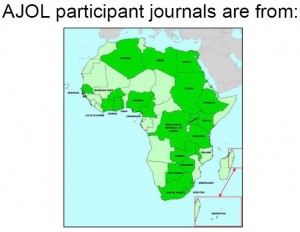
Figure 1a: Distribution of Journals in Africa (used with permission from Ms. Murray)
View Map of Africa in a larger map
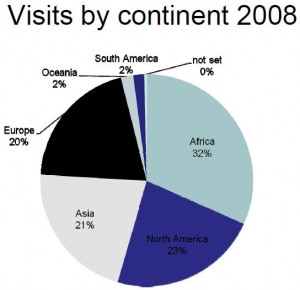
Figure 2: Visits by continent (used with permission from Ms. S. Murray)
(3) Comparison of old and new systems
After the overview and elaboration of the users and stakeholders of AJOL, Ms. Murray went into the details of the AJOL on OJS 2.2.2. She expressed the benefits of such a partnership with PKP led to better upgrading of the system. She found that more advanced versions could also be complied and were easier to upload which allowed for more capabilities in the platform that were not possible before. Figure 3 shows flowchart of the software and resources used ending with final product of the Open Journal Systems coded through the PHP scripting language using MySQL as the database management tool in the APACHE web browser run from the Linux operating system.
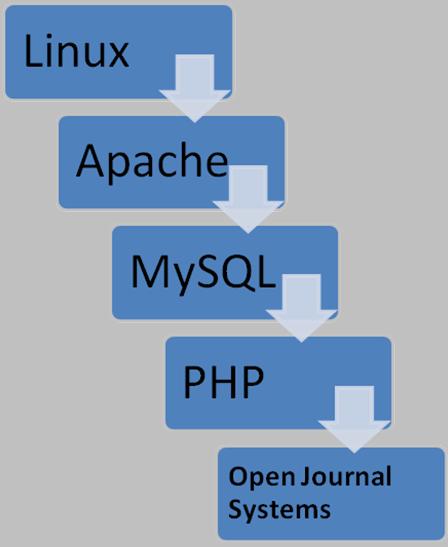
Figure 3: Software and Resources (created by Pam Gill)
A comparison of the new and old system is shown in Figure 4. The new approach is useful for all parties involved and is an excellent search tool with a new look and feel. Currently, as of July 2009, journals now manage their own AJOL pages in terms of the workflow management. In the future, Ms. Murray envisions that journals will be able to host their own versions of OJS on the PKP harvester which acts as a metadata aggregator. The newer versions will include a statistics package and offline plug-ins when connectivity is interrupted. The offline plug-in option will be crucial for users living in remote areas. Eventually, Ms. Murray envisions all journals being independent and managing their own pages.
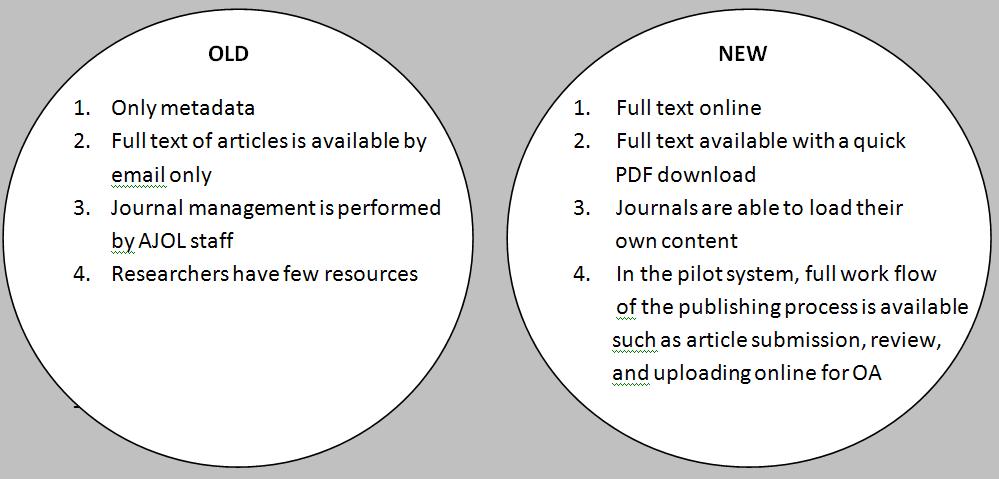
Figure 4: Comparison Chart of Old and New Systems (created by Pam Gill)
To conclude her presentation, Ms. Murray placed great emphasis on the need for the flow of global information from the North to the South (Evans and Reimer, 2009). She stressed the implementation of a new business plan that would allow journals to consider OA as a more viable possibility via AJOL/PKP. The full OJS functionality on AJOL has already made a huge difference as discussed earlier as open source software (OSS) has matured considerably. To summarize Ms. Murray ended her presentation one two key points to promote and continue the dissemination of literature in developing countries. First she brought forth the importance of carefully selecting the best tool that will take into account the needs of the users. Next, she advised to carefully align yourself with partners that you trust and who will support your initiatives for the right reasons. The following quote from Ms. Susan Murray herself summarizes these points:
“Relationships and communication are still the drivers of success, the technological tools are just the vehicle.”
– Susan Murray (2009)
This quote from Ms. Murray is used to illustrate that the technology can help propel the dissemination process in varying capacities. Technology depends on the specifications and limitations of the hardware and software. Yet, at the end of the day, relationships with others are the most important in terms of communicating, working collaboratively sharing ideas, which will ultimately lead to the success (or failure) of your goals and aspirations.
Questions from the audience asked at Ms. Murray’s session:
Question: Is AJOL published in other languages (referring to Figure 1 of African map from Susan’s PowerPoint slide)? Does AJOL have plans to bring more non-English journals to the portal?
Answer: Yes, we are hoping to introduce this to Francophone countries by starting the process of translating to French. So there will be an English/French option. We have a few journals published in Portuguese, Arabic. If we have a journal that is online (and space is NOT a problem) then we can publish in a local, indigenous and international language. Then at the same time research can be read by the local community and broadly by the rest of the world. This will increase readership and the journal will have met the needs to satisfy the best of both worlds.
Related Links
Conference attended by Susan Murray
Software/Sites
- African Journals Online
- OJS 2.2.2 Download
- PKP Open Archives Harvester: free metadata indexing system
References
Evans, J.A, & Reimer, J. (2009). Open Access and Global Participation in Science . Science. 323, 1025
Murray, S. (2009). Open journal systems (OJS) software as used by African journals online (AJOL). PKP Scholarly Publishing Conference 2009. Retrieved 2009-07-09, from http://pkp.sfu.ca/ocs/pkp/index.php/pkp2009/pkp2009/paper/view/216
July 11, 2009 1 Comment
Knowledge production through scholarly publishing in sub-Saharan Africa: a bibliometric analysis of the period 1996-2007
Presenter
Ezra Ondari-Okemwa, Senior Lecturer and Head, Department of Library and Information Sciences, University of Fort Hare, South Africa.
Session Overview
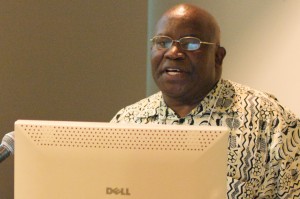
Photo: J. Miller - PKP Conference
Dr. Ondari-Okemwa introduced his talk by explaining that his research specifically focused upon the sub-Saharan region of Africa during its most productive period in terms of knowledge production, 1996-2007. The level of scholarly publication in sub-Saharan Africa is of critical importance, as this activity enables scholars to share what they know with their peers within the region. Such activity, researchers in sub-Saharan Africa can create new knowledge rather than only relying on scholarly research that emanates from the developed world.
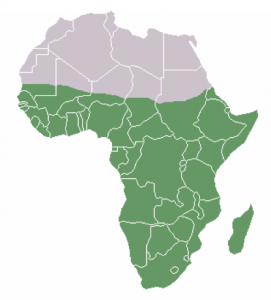
A map showing the boundaries of sub-Saharan Africa – South of the Sahara Desert
Ondari-Okemwa’s called into question the accuracy of indicators of scholarly publication from sources such as Thomson Reuters as its data focuses predominantly upon publications from North America, Europe as well as publications in the English language. He also identified that knowledge production was not uniform and took at least two dominant modes, only one of which benefited from the funding sources typically available to African researchers. The first mode of knowledge production is a linear one, one that is almost exclusively academic, investigator focused and discipline based. This mode of knowledge production leans heavily on scholarly publication. The second mode, one that started to emerge in the mid-twentieth century is far more context and problem-focused, with an interdisciplinary and reflexive orientation. This mode leans more towards the types of knowledge production we see in emerging interdisciplinary academic disciplines such as Developmental Studies, Knowledge Management and Gender Studies. This latter mode, seems particularly under-represented in the data on sub-Saharan African scholarly production, in part because funding sources are less likely to be found for such research in the social sciences than, in say, Medicine or Science. As such, the majority of the scholarly publications that were published during the time-period of the study (1996-2007) show a strong emphasis on science-based disciplines. Other disciplines were not widely represented.
Ondari-Okemwa also spoke to the potential benefits of Open Access and electronic journals in the context of scholarly activities in sub-Saharan Africa, specifically, and in Africa in general. Without question, the availability of such resources has had a positive impact on the research connections between the leading institutions. Such resources can be readily and exhaustively searched, readers can quickly move from citations to the cited works themselves with a single click, and the full range of bibliographic references are easily available and retrievable. However, a general state of technological deprivation in sub-Saharan Africa excludes most scholars from contributing to knowledge production in the region.
Ondari-Okemwa identified several key hurdles to scholarly publishing and knowledge production in Sub-Saharan Africa:
- There is little or no use of locally produced knowledge
- Invisibility of scholarly publications emanating from sub-Saharan Africa
- Technological hurdles such as poor Internet connectivity and low teledensity
According to Ondari-Okemwa, governments in sub-Saharan Africa need to address issues such as low and eroding salaries, social unrest and political conflicts including war, to address the reasons why so many people leave the region. In concluding, Ondari-Okemwa acknowledged the many strategic challenges facing most institutions of research and learning in sub-Saharan Africa, but felt strongly that steps needed to be taken to ensure higher rates of production of knowledge. These local scholars must play a role in this as they are best-placed to produce such knowledge about the region.
Question period
During the question period, several issues raised by the audience focused upon infrastructure challenges within African universities and the pressure upon scholars within those institutions to conduct their research in areas of interest to the developed world. Many in the room made reference back to the hurdles to scholarly publishing earlier mentioned by Ondari-Okemwa and to the fact that connectivity is a critically important factor that is limiting the possibilities for universities throughout Africa to engage more fully in research activities. With respect to funding for research, one audience member questioned whether or not the World Bank model of development really calls for the production of new knowledge from African countries. More often, it seems to narrowly task universities to reproduce existing research and to focus instead on increasing numbers of graduates in areas that align with its definitions of economic growth in the region. Ondari-Okemwa acknowledged that universities were increasingly being asked by government to shift to the mass production of graduates. The universities are caught up in a struggle with increasing enrolments without a concomitant increase in funding sources, and this results in fewer opportunities for scholars to focus on research activities.
Another issue that came up during the question period concerned the invisibility of many African scholarly journals. There are hundreds of journals that are not online and not visible being hidden within institutions and only available to a limited number of scholars and readers. Ondari-Okemwa responded by saying that it will be difficult to change this situation, though initiatives like African Journals Online is helping to make African journals more visible.
Related Links
Ondari–Okemwa, E. (2007). “Scholarly publishing in sub–Saharan Africa in the twenty–first century: Challenges and opportunities.”
First Monday, Volume 12 Number 10 – 1 October 2007
Ondari-Okemwa, E. (2004). Impediments to promoting access to global knowledge in sub-Saharan Africa. Library Management, 25(8/9):361-375.
Ondari-Okemwa, E. (2002). Challenges of harnessing virtual information resources: the case of the African Virtual University. Journal of Information Science 28(4): 321–329.
July 10, 2009 Comments Off on Knowledge production through scholarly publishing in sub-Saharan Africa: a bibliometric analysis of the period 1996-2007
Establishing a New Open Access Journal in Africa: The Case Study of the African Journal of Primary Health Care & Family Medicine (PHCFM): The Session Blog
Presenter: Pierre de Villiers
July 10th, 2009 at 2:00 p.m

(Used with permission from Pierre de Villiers)
Webstream
Background info
As a new discipline to Africa, Family Medicine needed a forum to communicate scholarly work throughout Africa. Ten countries in the neighbouring area of the Sub-Sahara joined together and through academic support and affiliation with well known academic associations started a new journal, The African Journal of Primary Health Care & Family Medicine (PHCFM). Their mandate was to ensure 20-30 publications were accepted and published per year. It delves into family medicine for the primary health care giver using African context. They use Open Journal Systems, and Creative Commons licence to ensure accessibility over the ten participating countries. They have multiple citations in Google scholar. The editor-in-chief is Professor Gboyega A Ogunbanjo from the University of Limpopo, South Africa. He is a specialist family physician.
The journal is mainly supported by the Flemish Inter-university Council (VLIR), a department for University Cooperation for Development, through the project VLIR-ZEIN 2006 PR320, but also has local support from Africa as well.
View Participating Partners in the new African journal, PHCFM in a larger map
Session Overview
Dr. de Villiers starts this session describing why he started this new journal. He has been the editor of the South African Academy of Family Practice/Primary Care journal (SAAFP) for the past ten years (the journal has fifty years of experience). Since that time, South Africa (SA) has made family practice into a specialty and now there is a great emphasis on primary health, care not only in SA but all over Africa.
He recognized many problems in communicating the knowledge of Family Practice in Africa:
- There were no full African journals at the time
- Most research was published in non-African-run journals
- It was difficult for African scholars to get published
SAAFP went online in 2005 as the first journal in Africa to do so. Open access to the journal started in 2006 and saw a dramatic effect on increased submissions to this journal as well as those articles sent to NEJM. Submissions were too numerous by far to publish solely in SAAFP and the need for a new journal was finally realized.
Once Dr. de Villiers decided to start this journal (PHCFM), he had standards he needed the journal to commit to.
- Published in English
- Peer reviewed
- Open access
- Onlne – for global visibility
- Rolling publication – articles could be published as they became available
- DOI – Crossref
- Ability to print on demand at end of every year
- Copyright – would use creative commons licencing to keep it open
- Credible Editorial board – Large African component as well as international made for highly visible editors
On November 18th, 2008, the official launch was in Kampala (picture above). Since then, the statistics on the journal have been staggering.
- Submitted 74
- Published 16
- Edited and accepted 11
- Declined 27 (36%)
- In-review 15
- Days-to-review 55, and days-to-publication 126
People are reading this journal, mostly from SA but a strong component are from Nigeria and the rest of the developing world. The website has registered over 2000 unique visitors this year, with 3.42 visits/person. People like what they see and 77% of people come back through internet bookmarks.
When Dr. de Villiers asked, what did we do right? He believes he had many good things working for him:
- Credibility of his editorial board – this gives the author/reader trust to submit articles as well as to use the journal as a reference tool
- Quality of editorial process (maybe too good with 36% rejection rate?)
- Sponsorship of funding and support
- OJS/online availablity
- Professional publishing service
This journal was endorsed by the World Association of Family Doctors (WONCA) at their 2009 conference and has been indexed in African Index Medicus. African Journals on Line (AJOL) will be accepting the journal this year, and they hope to be indexed in PubMed next year.
He states some of the challenges he has seen as well as anticipates seeing are:
- Need for continued funding (>5 years)
- High rejection rate
- Author support may be needed
- Additional funding to publish more articles (costs 500 euros per article)
When talking about the future of what he thinks the journal needs to do to stay visible and expand:
- Accreditation – needed from the Department of Education in order to get more funding (their application is being considered now)
- Continuing Professional Development credits needed
- XML publishing (under review)
- Thesis abstracts will start to be published July 2009
- French abstracts/articles will be started to help readership
Related Links
July 10, 2009 2 Comments

